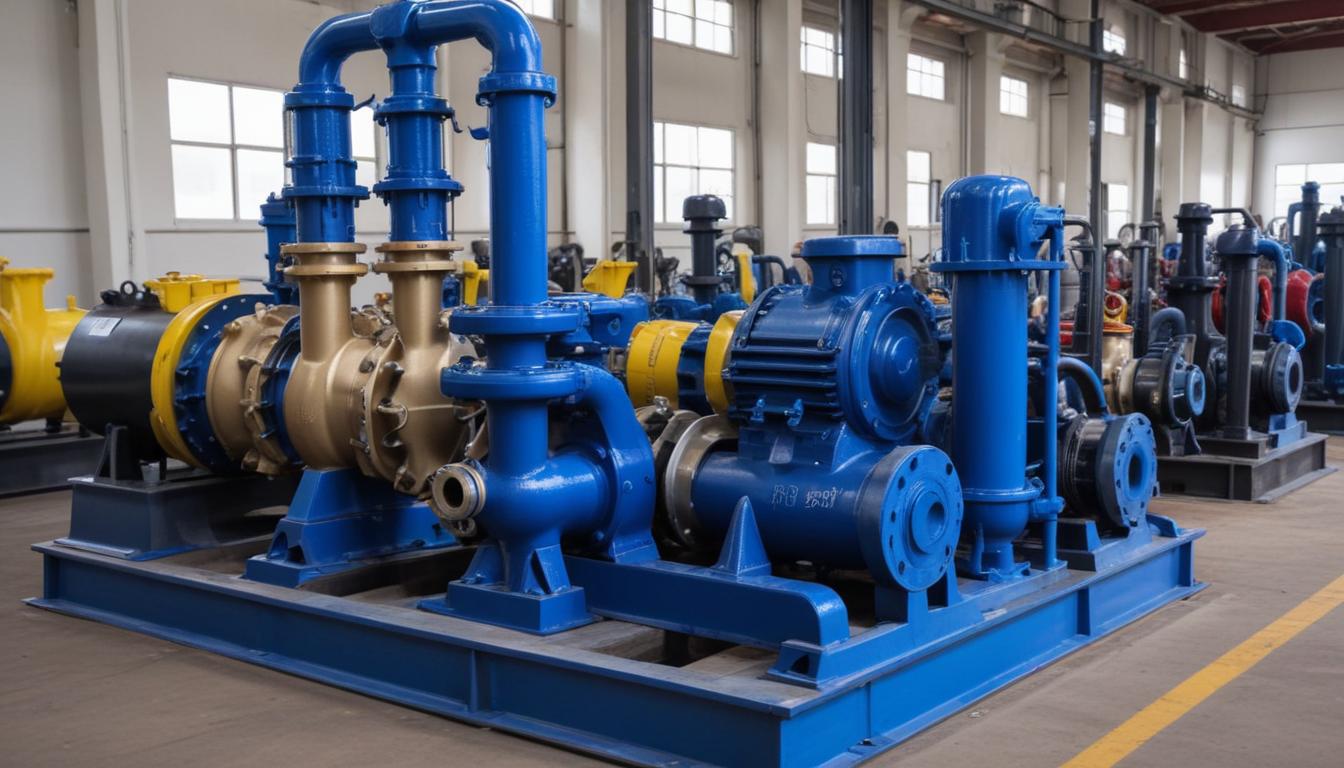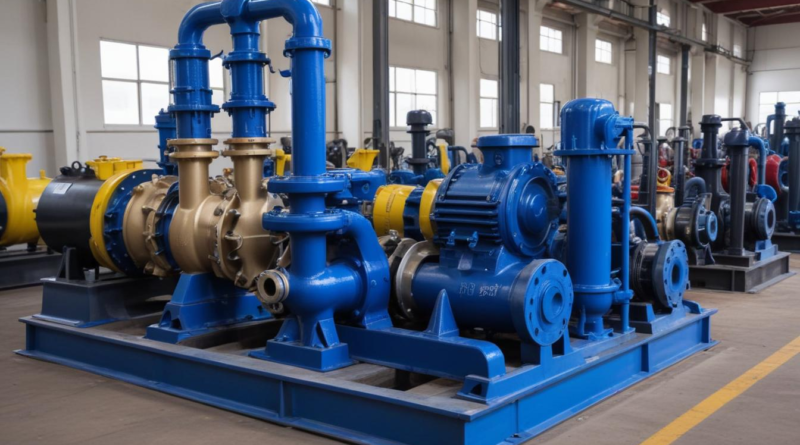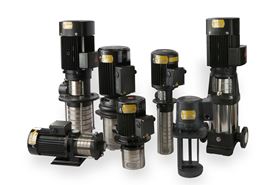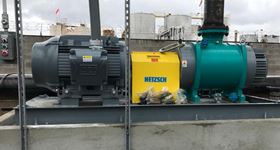understanding pump NPSH
Net Positive Suction Head (NPSH) is a fundamental hydraulic concept critical to ensuring optimal pump performance. It quantifies the pressure available at the suction port of a pump to prevent the formation of vapor bubbles, which can lead to cavitation—a phenomenon detrimental to pump operation and longevity.
NPSH is divided into two primary components:
- NPSHA (NPSH Available): Represents the actual pressure available at the pump suction, considering factors such as liquid properties, system configuration, and elevation differences.
- NPSHR (NPSH Required): Denotes the minimum pressure required at the pump suction to keep the liquid from cavitating, as specified by the pump manufacturer based on its design and operating conditions.
The relationship between these two components is pivotal:
| Component | Description |
|---|---|
| NPSHA | The actual head available in the system to supply to the pump. It is influenced by factors such as the fluid’s vapor pressure, atmospheric pressure, and the height of the liquid source. |
| NPSHR | The minimum head required by the pump to operate without cavitation. It is determined by the pump’s design and must always be met or exceeded by NPSHA. |
Understanding NPSH is essential for selecting the appropriate pump and designing a system that maintains efficient and reliable operation. Ensuring that NPSHA consistently exceeds NPSHR helps in mitigating issues related to vapor formation and maintains the integrity of the pump and the overall system.
importance of npsh in pump operation
Maintaining the appropriate Net Positive Suction Head is vital for several aspects of pump operation. Primarily, adequate NPSH ensures the prevention of cavitation, a detrimental phenomenon where vapor bubbles form within the liquid being pumped. Cavitation not only compromises the mechanical integrity of the pump by causing pitting and erosion of impeller surfaces but also significantly diminishes overall pump efficiency and performance.
Ensuring sufficient NPSH contributes directly to reliable pump performance. When NPSHA exceeds NPSHR, the pump operates within its optimal hydraulic range, minimizing energy losses and enhancing flow stability. This margin between available and required NPSH is crucial for accommodating fluctuations in system conditions, such as changes in liquid levels, temperature variations, or alterations in fluid properties.
Furthermore, the management of NPSH is integral to the longevity and maintenance of pump systems. By preventing cavitation and ensuring smooth operation, proper NPSH management reduces wear and tear on pump components, thereby extending the service life of the pump and decreasing the frequency of maintenance interventions. This reliability translates to lower operational costs and fewer disruptions in processes reliant on consistent pump performance.
The significance of NPSH in pump operation can be summarized as follows:
- Prevention of Cavitation: Maintains the integrity of pump components by avoiding the formation of vapor bubbles.
- Optimized Efficiency: Ensures that the pump operates at peak hydraulic performance, reducing energy consumption.
- System Reliability: Enhances the dependability of the pump system, minimizing unexpected downtime.
- Cost Efficiency: Lowers maintenance and repair expenses through sustained pump health and performance.
Additionally, understanding NPSH is a fundamental aspect of broader hydraulic concepts, enabling engineers and technicians to design and troubleshoot pump systems effectively. Consider the following table, which outlines the relationship between NPSH and key operational parameters:
| Parameter | Impact of Adequate NPSH | Impact of Inadequate NPSH |
|---|---|---|
| Flow Stability | Consistent and smooth flow with minimal fluctuations. | Erratic flow due to vapor bubble formation and collapse. |
| Energy Efficiency | Optimal energy usage aligned with pump design. | Increased energy consumption due to inefficiencies and additional strain on the pump. |
| Component Wear | Reduced wear and extended lifespan of pump parts. | Accelerated wear from cavitation-induced damage. |
| Operational Costs | Lower maintenance and repair costs. | Higher costs due to frequent repairs and potential pump replacements. |
In conclusion, the importance of NPSH in pump operation cannot be overstated. It is a critical parameter that influences the efficiency, reliability, and economic viability of pump systems. By ensuring that NPSHA consistently meets or exceeds NPSHR, operators can achieve sustained pump performance, mitigate risks associated with cavitation, and maintain the overall health of hydraulic systems.
calculating npsh available and required
Calculating the available and required Net Positive Suction Head is a critical step in ensuring that a pump operates without encountering cavitation. Accurate determination of these values involves understanding various system parameters and applying specific hydraulic equations.
Calculating NPSH Available (NPSHA):
The NPSH Available represents the actual pressure available at the pump suction. It is calculated using the following formula:
[ text{NPSH}_A = (P_{text{atm}} – P_{text{vapor}}) times frac{P}{rho g} + frac{H_s}{g} – frac{H_f}{g} ]
Where:
- Patm: Atmospheric pressure
- Pvapor: Vapor pressure of the liquid
- Hs: Height of the liquid source above the pump suction
- Hf: Friction losses in the suction line
- ρ: Density of the liquid
- g: Acceleration due to gravity
Calculating NPSH Required (NPSHR):
The NPSH Required is provided by the pump manufacturer and represents the minimum pressure needed to avoid cavitation. It is typically determined through pump testing and is specific to the pump’s design and operating conditions. However, it can also be estimated using the following empirical relationship:
[ text{NPSH}_R = frac{H_{text{cav}}}{g} + text{Safety Margin} ]
Where:
- Hcav: Head loss due to cavitation
- Safety Margin: Additional head to account for system variations
To streamline the calculation process, the following table outlines the key components and their roles in determining both NPSHA and NPSHR:
| Component | NPSHA Calculation | NPSHR Calculation |
|---|---|---|
| Atmospheric Pressure (Patm) | Contributes positively to NPSHA | Not directly involved |
| Vapor Pressure (Pvapor) | Subtracted from atmospheric pressure in NPSHA calculation | Influences cavitation head in NPSHR |
| Height of Liquid Source (Hs) | Added to NPSHA as a positive head | Not directly involved |
| Friction Losses (Hf) | Subtracted from NPSHA | Not directly involved |
| Head Loss Due to Cavitation (Hcav) | Not directly involved | Added to calculate NPSHR |
| Safety Margin | Not directly involved | Added to ensure robustness against system variations |
Step-by-Step Calculation Process:
- Determine Atmospheric Pressure (Patm): Obtain the current atmospheric pressure at the pump location, typically measured in Pascals (Pa) or pounds per square inch (psi).
- Identify Vapor Pressure (Pvapor): Find the vapor pressure of the liquid at the operating temperature from material property tables.
- Measure Height of Liquid Source (Hs): Calculate the vertical distance between the liquid source and the pump suction, usually in meters or feet.
- Calculate Friction Losses (Hf): Evaluate the pressure losses due to friction in the suction piping using the Darcy-Weisbach equation or friction loss charts.
- Compute NPSH Available (NPSHA): Apply the NPSHA formula incorporating the values obtained in the previous steps.
- Obtain NPSH Required (NPSHR): Refer to the pump manufacturer’s specifications or use the empirical relationship to estimate NPSHR.
- Compare NPSHA and NPSHR: Ensure that NPSHA exceeds NPSHR by an adequate safety margin to prevent cavitation.
Example Calculation:
Consider a centrifugal pump with the following parameters:
- Atmospheric Pressure (Patm): 101325 Pa
- Vapor Pressure (Pvapor): 2339 Pa (for water at 20°C)
- Height of Liquid Source (Hs): 5 meters
- Friction Losses (Hf): 2 meters
- Density of Water (ρ): 1000 kg/m³
- Acceleration due to Gravity (g): 9.81 m/s²
Calculating NPSH Available:
[ text{NPSH}_A = frac{(101325 – 2339)}{1000 times 9.81} + 5 – 2 ]
[ text{NPSH}_A = frac{99086}{9810} + 3 ]
[ text{NPSH}_A approx 10.1 + 3 = 13.1 text{ meters} ]
If the pump’s NPSH Required is 10 meters, the available NPSH exceeds the required by 3.1 meters, indicating safe operation without cavitation under the given conditions.
By meticulously calculating and analyzing both NPSH Available and NPSH Required, engineers can ensure that pump systems are designed and operated within safe hydraulic limits, thereby sustaining optimal pump performance and extending the lifespan of the equipment.
factors affecting npsh
 Several key elements influence the Net Positive Suction Head (NPSH) in pump systems. Understanding these factors is essential for optimizing pump performance and preventing issues such as cavitation. The primary factors affecting NPSH can be categorized into fluid properties, suction system design, pump characteristics, and operational conditions.
Several key elements influence the Net Positive Suction Head (NPSH) in pump systems. Understanding these factors is essential for optimizing pump performance and preventing issues such as cavitation. The primary factors affecting NPSH can be categorized into fluid properties, suction system design, pump characteristics, and operational conditions.
- Fluid Properties: The physical characteristics of the liquid being pumped play a significant role in determining NPSH. Key properties include:
- Vapor Pressure: Liquids with higher vapor pressures are more prone to vaporization, reducing the available NPSH.
- Temperature: Increased temperatures elevate vapor pressure, thereby decreasing NPSHA.
- Density and Viscosity: Higher density increases the gravitational component of NPSH, while higher viscosity can lead to greater friction losses in the suction line.
- Suction System Design: The configuration and condition of the suction pathway directly impact NPSH:
- Pipe Length and Diameter: Longer suction lines and smaller diameters increase friction losses, reducing NPSHA.
- Fittings and Valves: The presence of elbows, bends, and valves can add to pressure drops, diminishing NPSH availability.
- Elevation: The vertical distance between the liquid source and the pump affects the gravitational head contributing to NPSH.
- Pipe Roughness: Smoother pipes minimize friction losses, thereby enhancing NPSHA.
- Pump Characteristics: The design and type of pump influence the required and available NPSH:
- Impeller Design: Impellers with sharper edges or higher speeds can increase the likelihood of cavitation, raising NPSHR.
- Pump Type: Centrifugal pumps are particularly sensitive to NPSH variations, whereas positive displacement pumps may have different sensitivities.
- Pump Operating Point: Operating a pump away from its Best Efficiency Point (BEP) can affect the required NPSH.
- Operational Conditions: Variations in system operations can impact NPSH:
- Flow Rate: Changes in flow demand can alter suction velocities, affecting friction losses and NPSHA.
- System Pressure Changes: Fluctuations in downstream pressure can influence the overall hydraulic balance and NPSH.
- Temperature Fluctuations: Variations in operating temperature can change liquid properties, thereby impacting NPSH.
To further illustrate how these factors interplay and affect NPSH, consider the following table:
| Factor Category | Specific Factor | Impact on NPSH |
|---|---|---|
| Fluid Properties | Vapor Pressure | Higher vapor pressure decreases NPSHA, increasing cavitation risk. |
| Suction System Design | Pipe Length | Longer pipes increase friction losses, reducing NPSHA. |
| Pump Characteristics | Impeller Design | Sharper impellers may increase NPSHR, requiring higher NPSHA. |
| Operational Conditions | Flow Rate | Higher flow rates can elevate friction losses, diminishing NPSHA. |
Mitigating the Impact of Adverse Factors:
To maintain adequate NPSH and ensure reliable pump operation, it is crucial to address and mitigate the adverse effects of these factors:
- Optimize Suction Line Design: Minimize pipe length and use larger diameters to reduce friction losses. Employ smooth piping materials and limit the number of fittings and bends.
- Control Fluid Temperature: Where possible, regulate the temperature of the pumped liquid to maintain lower vapor pressures.
- Select Appropriate Pump Type and Impeller: Choose pumps and impellers that are less sensitive to NPSH variations and suitable for the specific fluid properties.
- Maintain Consistent Operational Conditions: Implement control systems to stabilize flow rates and pressures, minimizing fluctuations that can impact NPSH.
By carefully considering and managing these factors, engineers can ensure that the NPSH requirements are consistently met, thereby safeguarding the pump performance and extending the lifespan of the pump system. Integrating these considerations into the design and operational strategies is a fundamental aspect of effective hydraulic systems engineering.
preventing cavitation with proper npsh
Preventing cavitation is essential to maintaining the integrity and efficiency of pump systems. By ensuring that the Net Positive Suction Head (NPSH) is adequately managed, operators can effectively mitigate the risk of cavitation, thereby enhancing pump performance and prolonging the lifespan of the equipment.
Key Strategies to Prevent Cavitation:
- Ensure Sufficient NPSH Margin: Maintain a clear margin between NPSHA and NPSHR to accommodate fluctuations in system conditions. This involves accurate calculations and regular monitoring to ensure that available head consistently exceeds the required head.
- Optimize Suction Line Design:
- Minimize suction pipe length and use larger diameters to reduce friction losses.
- Avoid sharp bends, fittings, and valves that can cause turbulence and additional pressure drops.
- Use smooth piping materials to decrease roughness and further reduce friction losses.
- Control Fluid Temperature: Regulate the temperature of the pumped liquid to lower its vapor pressure, thereby increasing NPSHA and reducing the likelihood of vapor bubble formation.
- Maintain Consistent Flow Rates: Implement control systems to stabilize flow rates, preventing sudden changes that can negatively impact NPSH and lead to cavitation.
- Select Appropriate Pump and Impeller:
- Choose pumps with impeller designs that are less susceptible to cavitation, such as those with larger eye diameters and fewer sharp edges.
- Consider using positive displacement pumps in applications where maintaining a stable NPSH is challenging.
- Install Induction Loops or Air Vents: Incorporate devices that help remove entrained air from the suction line, ensuring that the pressure at the pump suction remains above the vapor pressure of the liquid.
- Regular Maintenance and Inspection: Perform routine checks to identify and rectify issues such as pipe leaks, blockages, or wear that can adversely affect NPSH and contribute to cavitation.
Implementation of these strategies can be systematically approached through the following table:
| Strategy | Action Steps | Expected Outcome |
|---|---|---|
| Ensure Sufficient NPSH Margin |
|
Consistent prevention of cavitation under varying conditions |
| Optimize Suction Line Design |
|
Reduced friction losses and increased NPSHA |
| Control Fluid Temperature |
|
Lower vapor pressure, enhancing NPSH availability |
| Maintain Consistent Flow Rates |
|
Stable NPSH and reduced risk of cavitation |
| Select Appropriate Pump and Impeller |
|
Enhanced resistance to cavitation and improved pump longevity |
| Install Induction Loops or Air Vents |
|
Reduced entrained air and stable suction pressure |
| Regular Maintenance and Inspection |
|
Early detection and mitigation of factors that could compromise NPSH |
Advanced Monitoring and Control Systems:
Integrating sophisticated monitoring systems can further enhance the prevention of cavitation. These systems can continuously track key parameters such as suction pressure, flow rate, and temperature, providing real-time data that allows for immediate adjustments to maintain optimal NPSH. Technologies such as Supervisory Control and Data Acquisition (SCADA) systems enable automated responses to deviations, ensuring that the pump operates within safe hydraulic limits.
Case Study Example:
Consider a chemical processing plant where maintaining a stable NPSH is critical due to the corrosive nature of the fluids being pumped. By implementing the following measures:
- Redesigned the suction piping to reduce length and increase diameter
- Installed an air separator to eliminate entrained air
- Utilized a pump with an impeller designed for high NPSH conditions
- Integrated a SCADA system for continuous monitoring
The plant successfully minimized cavitation incidents, resulting in improved pump reliability and reduced maintenance costs. The enhanced pump performance contributed to smoother operations and increased overall system efficiency.
By adopting these preventive measures and leveraging advanced hydraulic concepts, operators can effectively safeguard their pump systems against cavitation, ensuring sustained performance and operational excellence.




